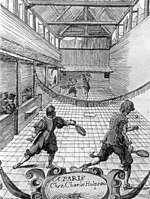Portal:Tennis/Selected article/6
Tennis can be traced as far back as the ancient Greek game of sphairistike (Greek: Σφαιριστική), and is mentioned in literature as far back as the Middle Ages in The Second Shepherds' Play, in which shepherds gave three gifts, including a tennis ball, to the newborn Christ. Sir Gawain, a knight of King Arthur's round table, plays tennis with a group of giants in The Turke and Gowin.
The Medieval form of tennis is termed real tennis. Real tennis evolved over three centuries from an earlier ball game played around the 12th century in France. This had some similarities to palla, fives, pelota, or handball, involving hitting a ball with a bare hand and later with a glove. One theory is that this game was played by monks in monastery cloisters, based on the construction and appearance of early courts. By the 16th century, the glove had become a racquet, the game had moved to an enclosed playing area, and the rules had stabilized. Real tennis spread in popularity throughout royalty in Europe and reached its peak in the 16th century.
In France, François I (1515-47) was an enthusiastic player and promoter of real tennis, building courts and encouraging play among the courtiers and commoners. His successor, Henri II (1547-59) was also an excellent player and continued the royal French tradition. During his reign, the first known book about tennis, Trattato del Giuoco della Palla was written in 1555 by an Italian priest, Antonio Scaino da Salo. Two French kings died from tennis related episodes--Louis X of a severe chill after playing and Charles VIII after being struck with a ball. King Charles IX granted a constitution to the Corporation of Tennis Professionals in 1571, creating the first pro tennis 'tour', establishing three levels of professionals-- apprentice, associate, and master. The first codification of the rules of real tennis was written by a professional named Forbet and published in 1599.

